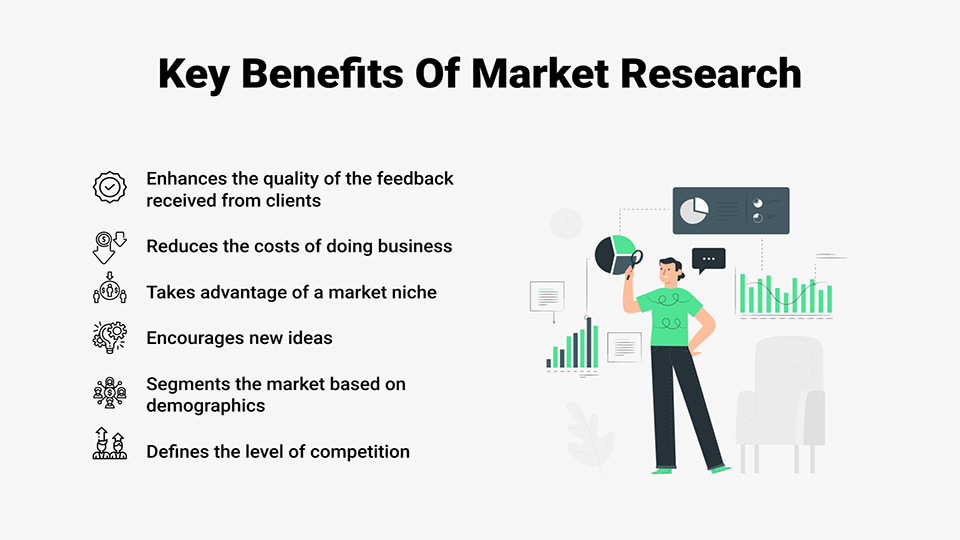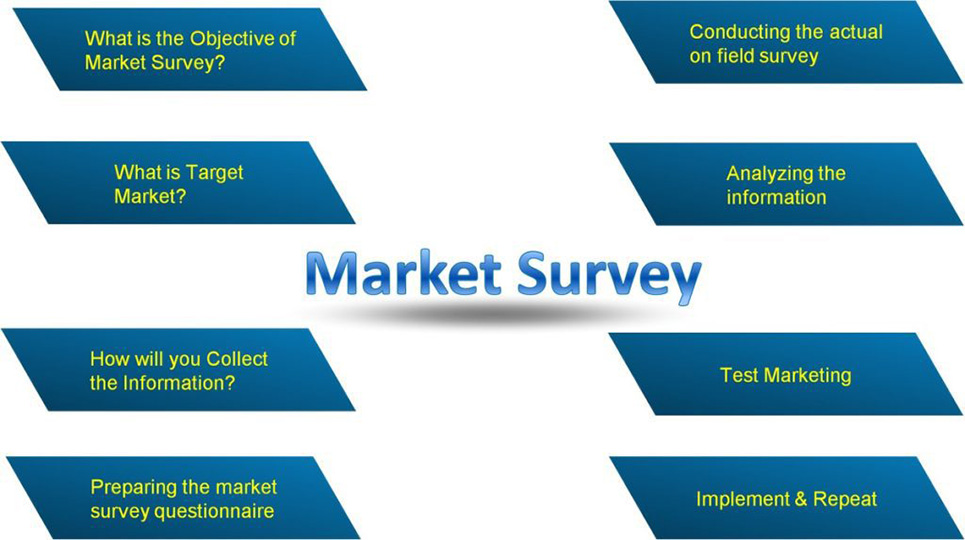Market Survey Questions are one of the techniques that we must take into account when we think about conducting a Market Survey, and this Survey should also include some questions,
for example:
- What is your age?
- What is your gender?
- What is your occupation?
- What is your income level?
- Have you purchased our product/service before?
- If yes, how satisfied were you with the product/service?
- What is the likelihood of you purchasing our product/service in the future?
- What are the primary factors that influence your purchasing decisions?
- How did you hear about our product/service?
- Would you recommend our product/service to others?
Definition of market survey questions and their importance

A MARKET Survey is a research method that gathers information from a sample of individuals or businesses about their attitudes, behaviors, preferences, and needs regarding a particular product, service, or industry.
Market Survey Questions are the specific questions that are asked in a market survey to collect the necessary information.
The importance of Market Survey Questions lies in their ability to help businesses make informed decisions about their products, services, and marketing strategies.
By collecting data from customers and potential customers, businesses can identify their target audience, determine customer needs and preferences, identify areas for improvement, and develop effective marketing campaigns.
Market Survey Questions can provide businesses with valuable insights into the following areas:
- Customer needs and preferences.
- Consumer behavior and purchasing habits.
- Perception of brand and competitors.
- Satisfaction with product or service.
- Price sensitivity and willingness to pay
- Marketing effectiveness.
- Demographic and psychographic characteristics of the target market.
Benefits of conducting a market survey

Conducting a market survey can bring numerous benefits to businesses. Here are some of the main advantages of conducting a MARKET Survey:
1-Understand customer needs and preferences: A MARKET Survey can help businesses understand their target audience’s needs, preferences, and behaviors, which can guide product development and marketing strategies.
2-Identify opportunities: A MARKET Survey can help identify new opportunities for growth and expansion, and inform businesses about potential markets and niches.
3-Improve products or services: MARKET Survey can provide feedback on existing products or services, enabling businesses to make improvements or changes to better meet customer needs and preferences.
4-Increase customer satisfaction and loyalty: By understanding customers’ needs and preferences, businesses can provide better customer service, resulting in higher levels of satisfaction and loyalty.
5-Guide marketing strategies: MARKET Survey can inform businesses about the most effective marketing channels, messaging, and tactics, resulting in more efficient and effective marketing campaigns.
6-Stay ahead of the competition: MARKET Survey can provide insights into competitor strengths and weaknesses, enabling businesses to stay ahead of the competition and differentiate themselves in the market.
Understanding Your Target Audience
Understanding your target audience is crucial for any business to succeed. Your target audience refers to a specific group of people.
Or customers that your product or service is intended for. Here are some key steps to understanding your target audience:
1-Define your ideal customer: Start by creating a detailed profile of your ideal customer, including demographic information such as age, gender, income, and education level.
And location, as well as psychographic information such as values, interests, and lifestyle.
2-Conduct market research: Use MARKET Survey methods such as surveys, focus groups, and customer feedback to gain insights into your target audience’s needs, preferences, behaviors, and pain points.
3-Analyze data: Analyze the data you collect to identify patterns and trends and use this information to refine your understanding of your target audience.
4-Create buyer personas: Use the insights from your research to create buyer personas, which are fictional representations of your ideal customers that capture their characteristics, goals, and pain points.
5-Tailor your messaging and marketing: Use your understanding of your target audience to tailor your messaging and marketing efforts to resonate with their needs and preferences.
6-Continuously evaluate and adapt: Regularly evaluate and adapt your understanding of your target audience based on feedback and new information to ensure that you remain relevant and effective in meeting their needs.
How to define your target audience?
Defining your target audience is a critical step in developing an effective marketing strategy. Here are some steps to help you define your target audience:
1-Identify your product or service: Start by clearly defining the product or service you offer.
This will help you determine the key features, benefits, and value propositions that you can offer to your customers.
2-Conduct market research: Conduct a MARKET Survey to gather information about your potential customers, such as their age, gender, income, education, location, interests, behaviors, and pain points.
You can use surveys, focus groups, or other research methods to collect this information.
3-Analyze your data: Analyze the data you collect to identify patterns and trends that can help you better understand your potential customers.
This will help you to create detailed buyer personas that represent the key characteristics and behaviors of your target audience.
4-Develop buyer personas: Develop detailed buyer personas that represent your ideal customers. Each persona should include information about their demographics, interests, behaviors, and pain points.
You can use this information to create targeted marketing messages and content that will resonate with your audience.
5-Refine your target audience: Refine your target audience by analyzing feedback and adjusting your buyer personas as necessary.
This will help you to ensure that your marketing messages and content remain relevant and effective.
Why identifying your target audience is crucial for market survey questions?

If you don’t know who your target audience is, you may end up asking questions that are irrelevant or confusing to them, which can lead to inaccurate or incomplete data.
Here are some specific reasons why identifying your target audience is important for Market Survey Questions:
1-Tailored questions: Different groups of people have different needs, preferences, and experiences, and asking the same questions to everyone may not capture these differences.
Identifying your target audience allows you to tailor your survey questions to their specific characteristics and interests.
2-Language and terminology: Different groups of people may use different language and terminology to describe the same things.
Identifying your target audience allows you to use language and terminology that are familiar and meaningful to them, which can increase the accuracy and relevance of your survey responses.
3-Understanding their behavior: Different groups of people may have different behaviors, habits, and attitudes that influence their opinions and decision-making.
Identifying your target audience allows you to ask questions that help you understand these factors and how they relate to your products, services, or marketing efforts.
4-Efficient use of resources: Surveying a large and diverse group of people can be time-consuming and expensive.
Identifying your target audience allows you to focus your survey efforts on the people who are most likely to be interested in your products, services, or marketing efforts, which can save time and resources.
Tips for creating effective questions for your target audience
Here are some tips for creating effective questions for your target audience in the MARKET Survey:
1-Use clear and concise language: Use language that is easy to understand and avoid using jargon or technical terms that may be unfamiliar to your target audience.
Keep the questions short and to the point, and avoid using complicated sentence structures.
2-Ask specific and relevant questions: Ask questions that are specific and relevant to your target audience, and avoid asking general or vague questions.
For example, instead of asking “Do you like our product?”, ask “What specific features of our product do you like/dislike?”
3-Avoid leading questions: Avoid asking questions that suggest a particular answer or bias the respondent’s opinion.
For example, instead of asking “Do you agree that our product is the best in the market?”, ask “What are your thoughts on our product compared to other similar products in the market?”
4-Use open-ended questions: Use open-ended questions that allow the respondent to provide detailed and specific answers.
Open-ended questions can provide more insights into the respondent’s thoughts and opinions and can help you understand their reasoning and motivations.
5-Use rating scales: Use rating scales that allow the respondent to provide a range of responses, such as Likert scales or numerical rating scales.
Rating scales can provide more nuanced information and allow you to compare responses across multiple questions.
6-Test your questions: Test your survey questions with a small sample of your target audience before distributing the survey to ensure that the questions are clear, relevant, and effective in capturing the information you need.
Types of Market Survey Questions
Market Survey Questions are used to gather information from a target market or customer base. The type of questions used in.
A MARKET Survey can affect the quality and usefulness of the data collected. Here are some common types of Market Survey Questions:
1-Closed-ended questions: These questions typically have a limited set of response options
(such as yes or no, multiple choice, or rating scales) and are useful for gathering specific information in a structured way.
- Example: Have you ever purchased a product from our brand? (Yes/No)
2-Open-ended questions: These Market Survey Questions allow respondents to provide more detailed and nuanced responses in their own words.
They are useful for gathering insights and opinions that may not be captured by closed-ended questions.
- Example: What do you like and dislike about our product?
3-Demographic questions: These questions help to segment the survey data by characteristics such as age, gender, income, education, or location.
- Example: What is your age range? (18-24, 25-34, 35-44, 45-54, 55+)
4-Likert scale questions: These Market Survey Questions ask respondents to rate their level of agreement or disagreement with a statement, usually on a scale from strongly disagree to strongly agree.
- Example: I am satisfied with the customer service I received from this company. (Strongly disagree, disagree, neither agree nor disagree, agree, strongly agree)
5-Behavioral questions: These questions ask about past or current behavior related to a product or service.
Such as how often someone uses a particular feature or how likely they are to recommend it to others.
- Example: How frequently do you use our product on a weekly basis? (Less than once a week, 1-2 times a week, 3-4 times a week, 5+ times a week)
6-Attitudinal questions: These questions ask about respondents’ opinions, beliefs, and attitudes toward a product, service, or brand.
- Example: How important is sustainability to you when making a purchase decision? (Very important, somewhat important, not very important, not at all important)
Best Practices for Creating Market Survey Questions
Creating effective Market Survey Questions is crucial for gathering valuable insights.
From your target market or customer base. Here are some best practices to keep in mind when crafting your Market Survey Questions:
1-Start with a clear goal: Begin by defining the purpose of your survey and the specific information you want to gather.
This will help you create questions that are focused and relevant to your goals.
2-Keep it simple and concise: Use clear, simple language and avoid using technical jargon
Or industry-specific terms. Keep your questions short and to the point, and avoid asking multiple questions in one.
3-Avoid leading questions: Questions that suggest a particular answer or contain bias can influence respondents and skew the results.
Ask neutral questions that don’t guide respondents toward a particular answer.
4-Use a mix of question types: Use a variety of question types to gather different types of data,
such as closed-ended questions for specific information and open-ended questions for more detailed insights.
5-Consider the order of questions: Arrange your questions in a logical order that flows well and makes sense. Start with easier, more general questions and move on to more specific and complex questions later in the survey.
6-Test your questions: Before launching your survey, test your questions with a small group of people to ensure they are clear and easy to understand. This can help you identify any confusing or problematic questions that need to be revised.
7-Respect respondents’ privacy: Be transparent about how you will use the data you collect and ensure respondents’ privacy is protected. Avoid asking personal or sensitive questions unless they are necessary for your research.
Tips for Conducting a Successful Market Survey
Conducting a successful MARKET Survey involves more than just creating good survey questions.
Here are some tips to help you plan and execute a successful MARKET Survey:
1-Define your target audience: Identify the specific group of people you want to survey
and make sure your questions are relevant to their needs and interests.
2-Choose the right survey method: Decide whether an online survey, phone survey, mail survey,
or in-person survey is the best way to reach your target audience.
Consider factors such as cost, response rate, and the level of detail you need.
3-Set a clear timeline: Determine a specific start and end date for your survey and communicate this clearly to your target audience.
Give respondents enough time to complete the survey but avoid letting it drag on too long.
4-Offer incentives: Consider offering an incentive, such as a discount code or a chance to win a prize.
To encourage people to take your survey.
This can increase response rates and help you gather more data.
5-Promote your survey: Spread the word about your survey through email, social media, or other marketing channels to reach your target audience.
Be sure to highlight the benefits of participating and keep your messaging clear and concise.
6-Analyze and share your results: Once your survey is complete, analyze your data and share the results with your team or stakeholders.
Use the insights you gather to inform your marketing strategy and improve your products or services.
7-Follow up with respondents: Thank respondents for participating in your survey and sharing any insights.
Or findings that you think might interest them. This can help build goodwill and maintain a positive relationship with your audience.
The best practices for creating and conducting market surveys
MARKET Surveys are an important tool for businesses to gather information about their target audience, competitors, and industry trends.
Here are some best practices for creating and conducting an effective MARKET Survey:
1-Clearly define your objectives: Before creating your survey, clearly define your objectives and what you hope to achieve from the survey.
This will help you create questions that are focused and relevant to your goals.
2-Identify your target audience: Know who you want to survey and why.
Define the demographic and psychographic characteristics of your target audience,
such as age, gender, location, income, and interests.
3-Keep it short and simple: People have limited attention spans,
So keep your MARKET Survey short and simple.
Make sure your questions are clear and easy to understand. Avoid using jargon or technical terms that might confuse respondents.
4-Use a mix of question types: Use a mix of open-ended and closed-ended questions to gather qualitative and quantitative data.
Closed-ended questions can be answered with a yes or no or multiple-choice answer,
while open-ended questions allow respondents to give more detailed answers.
5-Avoid leading questions: Leading questions can bias your results and lead to inaccurate conclusions. Make sure your questions are neutral and not biased towards a particular answer.
6-Test your survey: Before launching your survey, test it on a small group of people to ensure
that it’s working properly and that your questions are clear and easy to understand.
7-Offer incentives: Offering incentives such as discounts, gift cards,
or other rewards can increase response rates and motivate people to complete your survey.
8-Analyze and share results: Once you’ve collected your data, analyze it and share your results with your team.
Use the insights you’ve gained to make informed decisions about your business strategy
and improve your marketing efforts.
Conclusion
Finally, choosing Market Survey Questions carefully is reflected in the results of the Survey,
so the MARKET Survey must include some questions that reflect the description of the audience, so we mentioned a model of Market Survey Questions in the paragraphs of our article.
Share via:



